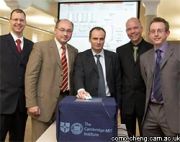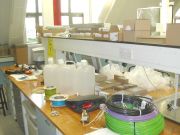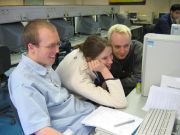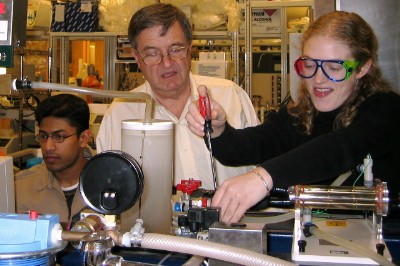Introduction to Weblabs
The Internet offers enormous potential for teaching and over the latest years the development of tools and courses have exploded. Web-based teaching has several advantages like:
- The resources are available anywhere as long as you have access to a computer with the relevant software
- No restrictions on space or time are present
- The technology is easy to use
- Web based material is easy to update
- The Web provides a student-centred learning environment
In the group, we use web based teaching to support lectures and to provide unique learning opportunities for the students by using real experiments accessible via the Internet.
Aims of the Weblabs Project
Increasingly, critical and expensive processes in the chemical industry are controlled remotely by computers operating in networks. Companies like BASF use the technology and Procter & Gamble are restructuring their experimental facilities on site to be able to operate processes remotely via their intranet. Current laboratory courses in the chemical engineering curriculum provide little training to prepare students for this. Thus there is an urgent need for robust and realistic training in these tools and processes. By the use of internet accessible experiments, operating remotely, with software widely used in the industry, the students will be trained to use what they are likely to encounter when leaving the university.
- Training. By using an interface widely used for remotely controlled processes in the industry, the students are familiar with this when leaving the university.
- Remote Access. Freedom for students to perform the experiment without physically being in the laboratory. Students can perform the experiment from home and and access and perform an experiment physically located anywhere in the world.
- Communication. The students log on to the experiment from individual computers but perform the experiment in a group. The students communicate between themselves and with the tutor using a chat.
- Visualisation. By performing a real experiment the students also get the traditional benefits of laboratory experiments: visualization of important theories and hands on experience.
Previous Work - The MIT iLabs
In 1999 MIT and Microsoft announced an alliance to conduct research and create new technologies to improve information technology-enabled teaching models and educational tools for university education. The project was dubbed iCampus and is running for five years with a budget of $25 million. As a part of this, a number of laboratory experiments, iLabs, have been developed. In one iLab, Professor Clark Colton of the Department of Chemical Engineering at MIT has set up a heat exchanger for online use in lectures within the course "Transport Processes". This experiment has been used in the education of chemical engineers since November 2001.
 |
| The MIT heat exchanger controllable via the Internet |
The Project
Early in 2003 a proposal to include the MIT heat exchanger experiment in the course for the Cambridge students and to develop a second experiment on Residence Time Distribution and Reaction Kinetics to be placed in Cambridge for use by students from Cambridge and MIT was submitted to the Cambridge-MIT Institute, (CMI). The proposal was successful and in September 2003 a three year project commenced to execute this work. Anders Selmer and Teaching Consortium Teaching Fellow Mike Goodson have been running a control exercise with Cambridge students using the MIT heat exchanger since the Lent term, 2004. A reactor was chosen for the Cambridge weblab. There are several reasons for this choice: knowledge of reactors is the very core of chemical engineering; the course on reactors is not accompanied by a laboratory course; and finally, the setup is very flexible (i.e. can be used for different assignments) and well suited to be controlled remotely.
Exercises
The courses on Process Dynamics & Control and Reactors are accompanied by exercises that are extended activities, undertaken individually, designed to test the students' knowledge of ideas covered in lectures. The exercises, although based on the course material, aims to challenge the students and extend their understanding. To practice presenting work clearly and concisely, each student writes a report on the exercise.
Space and time restrictions do not allow for a hands-on laboratory experiment to be added to these courses. By incorporating an experimental session, operated over the Internet, in the exercise, the course goals are met and the students get the traditional benefits of a laboratory experiment. It also exposes them to remote-control software. The advantages of these exercises are therefore twofold: experiments can easily be performed on real systems (as opposed to simulations) where equipment would otherwise be unavailable, and students gain knowledge of remote-control software such as that used in research and industry.
Process Dynamics & Control
Process Dynamics and Control is the title of a one-term course of 16 lectures taught in the second year of chemical engineering at the University of Cambridge. It aims to give students a variety of skills, such as how to write correctly formulated mass and energy balances and how to analyse and design controllers.
Reactors
There are three courses devoted to reactors in the first and second years of chemical engineering at the University of Cambridge. Reactors also appear in many other courses such as biotechnology, chemistry and process systems. It is necessary for a chemical engineer to be able to select and design reactors. Key factors include choice of flow pattern, prediction of yield, selective manufacture of desired products, temperature control, and the role of mass transfer. The subject is relevant to operations taking place in the chemical, minerals, biochemical and food industries, and can play a vital part in environmental control. By using correct design and operation, the chemical engineer can control and manipulate the chemistry in order to ensure efficient and reliable processing.
Media Coverage of the Weblabs
General News Items
Cambridge University 2004 News Item (PDF 22.77 KB)
TCE Article - 'Process Control Across the Pond' - July 2004 (PDF 260.17 KB)
Engineering Talk Article (PDF 78.68 KB)
TCE Article - 'Join the Weblab Revolution' - July 2007 (PDF 214.96 KB)
The Launch
Cambridge University 2006 News Item (PDF 23.38 KB)
Cambridge Evening News Article (PDF 42.5 KB)
Chemistry World Report (PDF 35.09 KB)
VDI Nachrichten Article (PDF 1.25 MB)
Computational Modelling Group's Weblabs News Items
Cambridge Weblab Goes Live!

The opening ceremony for the Cambridge Weblab, developed by members of the CoMo Group, took place on the 8th December 2006. This event brought together delegates from industry and universities with a common interest in process control, chemical engineering, and e-learning. In addition, there were several dignitaries in attendance, including the Pro-Vice-Chancellor of the University of Cambridge, Prof. Ian Leslie and Executive Director of the CMI, Prof. Mike Gregory. Demonstrating the Weblab's capacity for remote operation, the opening took place via an internet connection, with the official commissioning accompanied by speeches and talks. After the opening, the delegates were able to get hands-on experience of the Weblab during a discussion and demonstration session followed by a lunch at Emmanuel College.
Pictures from the reactors exercise

As a part of the CMI funded Web Based Teaching Project we have constructed and built an experimental rig with a chemical reactor. It was used for the first time during Lent term 2006 as part of an exercise on non ideal reactors.
Building a Weblab on Reactors

In parallel with the sucessful use of the MIT iLabs heat exchanger as part of an exercise, we have been planning for building our own experiment on chemical reactors. Suppliers of custom built experimental equipment were contacted and a collaboration with Siemens Automation was started to use industrial hard and software for control and operation of the experiment and for broadcasting it to the Internet. The result of the efforts described here is the Reactors Weblab.
Weblabs in Chemical Engineering Workshop

As part of the Cambridge-MIT Institute-sponsored "Weblabs in Chemical Engineering" project we hosted a workshop on 8 July 2005 in the Møller Centre. Participants and speakers came from 10 countries in Europe and America to share experiences and discuss the possibilities of internet accessible laboratory experiments in chemical engineering education.
Control Exercise

To explore the theory of PID control in practice the students connected to an experimental setup based at the MIT via the Internet. The students could hereby gain access to real equipment generating real data in real time. The interface used for operating the experiment is widely used in the industry and the students are likely to meet it again in their professional life.
Cambridge Students Perform Experiment at MIT over the internet - a CMI funded initiative

For the first time in 2004, Chemical Engineering Students from the University of Cambridge, UK, performed an experiment located at MIT in Boston on Process Control. The students connected to this experiment, located on the other side of the Atlantic, over the internet. They applied their knowledge of process control, a topic taught in the Chemical Engineering course, to tune a controller for the hot inlet temperature of a heat exchanger. The control and observation of its response was done via a web interface. This experiment replaced a pen and paper exercise of an idealised system for the Process Dynamics and Control Course.



